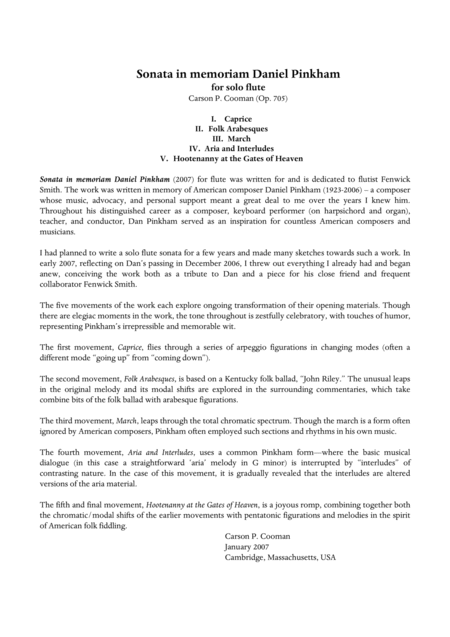Flute Solo - Level 5 - Digital Download SKU: A0.533567 Composed by Carson Cooman. Concert,Contemporary,Standards. Individual part. 18 pages. Musik Fabrik Music Publishing #3022373. Published by Musik Fabrik Music Publishing (A0.533567). I. CapriceII. Folk ArabesquesIII. MarchIV. Aria and InterludesV. Hootenanny at the Gates of HeavenSonata in memoriam Daniel Pinkham (2007) for flute was written for and is dedicated to flutist FenwickSmith. The work was written in memory of American composer Daniel Pinkham (1923-2006) â a composerwhose music, advocacy, and personal support meant a great deal to me over the years I knew him.Throughout his distinguished career as a composer, keyboard performer (on harpsichord and organ),teacher, and conductor, Dan Pinkham served as an inspiration for countless American composers andmusicians.I had planned to write a solo flute sonata for a few years and made many sketches towards such a work. Inearly 2007, reflecting on Danâs passing in December 2006, I threw out everything I already had and begananew, conceiving the work both as a tribute to Dan and a piece for his close friend and frequentcollaborator Fenwick Smith.The five movements of the work each explore ongoing transformation of their opening materials. Thoughthere are elegiac moments in the work, the tone throughout is zestfully celebratory, with touches of humor,representing Pinkhamâs irrepressible and memorable wit.The first movement, Caprice, flies through a series of arpeggio figurations in changing modes (often adifferent mode âgoing upâ from âcoming downâ).The second movement, Folk Arabesques, is based on a Kentucky folk ballad, âJohn Riley.â The unusual leapsin the original melody and its modal shifts are explored in the surrounding commentaries, which takecombine bits of the folk ballad with arabesque figurations.The third movement, March, leaps through the total chromatic spectrum. Though the march is a form oftenignored by American composers, Pinkham often employed such sections and rhythms in his own music.The fourth movement, Aria and Interludes, uses a common Pinkham formâwhere the basic musicaldialogue (in this case a straightforward âariaâ melody in G minor) is interrupted by âinterludesâ ofcontrasting nature. In the case of this movement, it is gradually revealed that the interludes are alteredversions of the aria material.The fifth and final movement, Hootenanny at the Gates of Heaven, is a joyous romp, combining together boththe chromatic/modal shifts of the earlier movements with pentatonic figurations and melodies in the spiritof American folk fiddling.
